The hands are a tell all of life and a person's activities, unless they have exceptionally good healing and grooming skills. As such, knowing hands and choosing the right one for your character can make your character more realistic, sympathetic and knowable. Not a lot of attention is given to hands but they do express a lot and so the occasional notation, when writing, of the hands can help ground your work and character. For illustrated works, choosing the right type of hand is essential and knowing how to draw them even more so. So, below is a list (in no particular order) of hand types, what they look like and some of what history they express. Choose wisely.
Old hands: fragile skin, liver spots, reduction in fat, bones and cartilage appear larger, possible swelling of knuckles, visible blood vessels, wrinkles and scabs and likely longer nails for nail cutting becoming difficult. They can be either surprisingly strong or like fluttering butterflies.
Young hands: mostly unwrinkled, freckles or new scars likely to be the only markings, slightly podgy, smooth and un-calloused, shorter nails (likely to be biters), grubby under nails for playing, no movement issues so these hands are nimble and quick enough for little pickpockets.
Piano player's hands: the most important features are flexibility and longer fingers with the final phalanges being thin enough to hit only one key at a time, otherwise piano player's can have hands of all sort. Piano player hands can be old, young, podgy, thick, meaty, thin, double jointed, sleek etc. Also of importance, the nails are usually shorter to avoid the extra click when a key is pressed.
Sleek or thin hands: often mildly calloused from activities like playing a musical instrument, typing, fine mechanical work etc. Having such hands provides the possessors an opportunity to become skilled in areas those with shorter digits can't, thus the higher proportion of those with longer fingers becoming musicians than those with shorter, dreams aside.
Doctor's hands: can come in almost any size and shape although surgeons tend to do a little better when their fingers are nimble enough to handle needles etc. This does not mean that surgeons all have the hands of musicians. Far from it. Nimbleness is the key, not thinness or anything else. The most common features, particularly of more experienced doctors, is the wear and tear of the skin caused by repeated chemical exposure and callouses from repetitive behaviour (surgeon's on the fingers, other doctors elsewhere depending on what action is being repeated.)
Workman's or labourer's hands: are usually thicker for muscle, leathery for callouses and sun exposure, stained from chemicals, dry from excessive cleaning, torn or scarred skin and shredded cuticles from handling rough materials, torn or bitten nails (biting as this is the quickest method of stopping a tear from becoming worse) that are filled with dirt, prematurely wrinkled. To those who have them they are sometimes painful badges of honour. Those without them are usually sneered at by those with them as those without can be seen as weak, incapable and lazy.
Wrestler's hands: bare some of the same hallmarks as the worker's hands, being thick, muscled, calloused and dryer from chemicals. Damage is often on the fingers rather than the knuckles due to the higher proportion of throws and holds to blows in wrestling.
Boxer's or hand-to-hand fighter's: surprisingly come in two main sorts. There's thick and meaty but with little skin damage due to gloves being worn. There's also thick and meaty and scarred from no gloves being worn. Both are likely to be quite smashed up for seasoned fighters as the more fighting experienced the more likely the smaller bones in the hands and wrists have been broken or shattered at one point and/or another. Hands failing is one of the most likely reasons for a fighter quitting, alongside brain damage, weakened knees or ankles.
Extra fingers: can produce hands that are sometimes painful or dysfunctional but mostly they aren't. The fingers can be melded together or offset or even replace another expected digit. For those with an extra finger pointing in the same direction as the others it can mean greater speed and skill in certain activities like typing or playing a musical instrument. For those with fingers offset or pointing in a separate direction they can be like an extra tool good for specific jobs. Webbed or melded fingers usually end up surgically separated at the very least, with the extra digit to the side sometimes removed. There is a tendency for viewers to be startled but the high functionality of extra fingers for their possesses often makes the possessor quite happy with the situation. Not everyone dashes for a plastic surgeon≥
Naturally coloured or discoloured nails: are usually of the off colours. Discoloured ones are usually brown, green, black, white or yellow. Coloured ones, as often appear on monsters, can be red, black, green yellow, brown etc. and tend to be disconcertingly sharp and/or filthy.
Extra long nails: are usually dysfunctional unless the character has supernatural powers. They are for decoration, for producing sonic sounds from stringed instruments, for slashing and for scaring. They predominantly appear on women but some male monsters or cross dressers may have long nails, although such characters are far rarer again.
Clawed hands: can be with or without actual claws. To have a claw hand without claws can be the result of injury or age, which has permanently fix the hand in a claw like shape. Also, there is a gesture that mimiks the appearance of claws. For actual clawed hands, the claws appear in place of fingernails while the thumb is no longer always set as opposable. Although birds often have claws with a single claw curling in the opposite direction to the others, not all do and many other clawed creatures don't have a thumb-like claw. Instead, there can be a claw further up the leg or arm or all digits being like fingers.
Knife hands: are those with blades of one sort or another protruding from the hands or fingers. They are sometimes referred to as claws but blades aren't the same as claws. They are unnatural additions and are incredibly durable. Some damage may occur to the hands when the blades are produced or used, forming extensive callouses and scarring in particular areas.
Thumbless hands: can be the result of injury or just birth. It is much harder to hold things without a thumb so the remaining fingers are often used in a different manner to compensate. There is also a tendency for two hands to be used instead of one when finer objects are being handled or when greater care is needed (such as with hot drinks etc.).
Double thumbed hands: come in three main shapes and vary in functionality. There is thumb duplication where the thumb is on the same side but in one sort the second thumb points in the same direction as the first while in the other sort the second thumb points in the opposite direction to the first. The remaining sort is where the hand is mirrored around the third digit to produce thumbs on either side and two second and third fingers, a possible extra included.
Tattooed or hennaed hands: can be pretty or rough in appearance, depending on the desired look. Henna is traditionally worn by women while fully tattooed hands belong predominantly to men. There are men and women who chose the opposite course though. Either sort can be a statement or a traditional expression for certain life events.
Baby hands: are tiny, quite strong, pudgy and dimpled. The nails are unbelievably tiny and soft.
Dimpled hands: are hands that have retained the baby dimples to a later age. While they are usually of young children, adults can still have dimpled hands. Above is a dimpled hand of mine. Dimples are produced by meaty, thick or podgy hands having the skin stuck close to the tendon over the knuckle. The remaining meat or fat lifts the surrounding skin higher, producing the dimple. The presence of fat is usually what causes dimples in the young, with disappears with age. Meatier hands is usually what causes dimples in the old unless the person is obese. (I've meaty and thick fingered hands by the way, as I have hands like my father's though a couple of sizes smaller and with less chemical exposure - he's a doc.)
Swelling.
Swelling.
Fat hands.
Swelling.
Podgy, swollen or fat hands: usually belong to the young and/or overweight. Fat hands can also due to localised water retention, infection or as a symptom of another condition such as pregnancy etc.
Robotic hands: are imitation hands made from mechanical parts that are sometimes placed on robots and sometimes used as artificial hands, often futuristic.
Artificial or prosthetic hands: are not normally as functional as the possessors would like but they do provide looks or enough minimal function to be better than having no hand, for the most part. Levels of frustration depend on how good the hand is (there is quite a variety) and the personality of the possessor.
Three fingered hands: can be three fingers and one thumb or two fingers and one thumb, depending on who is doing the counting. Three fingers and a thumb is typical of cartoon characters as they are easier to draw.
Four fingered hands: can be three fingers and a thumb or normal human hands, depending on who's counting. The three fingers and a thumb arrangement in humans can be the result of birth or injury.
Expressive hands: are usually the result of culture as the expressiveness refers to the gesticulations often performed. Otherwise, expressiveness can be a reflection of act upon character. Hands used to perform sign are usually highly expressive and convey the culture of the localised hearing impaired community.
Extended pointer (usually second or third finger): are usually possessed by aliens, monsters, creatures and demons when it comes to fiction. Sometimes all the digits are stretched to produce creepy hands, such as the alien face hugger 'hands'.
Bony hands: are usually of the old and the thinner adults. Tendons and blood vessels are easily visible, as are the contours of the knuckles and joints. In adults, the blood vessels are just lumps under tight skin but in older hands the blood vessels are lines of blue networking under very thin and fragile skin.
Skeletal hands: belong to walking skeletons, mostly rotten zombies, mummies, acid victims before the bone deteriorates as well etc. They are the stuff of fiction unless there is a model skeleton or real display about. Such displays would normal appear in a doctor's office, if they're a quack or richer (in fiction and sometimes reality, that is). Skulls are usually preferred by doctors, though.
Arthritic hands: are the painful result of worn down cartilage and swelling of the joints. The hands can become twisted, with clawed hands being one of the many results. They are often a sign of old age but arthritis can appear at any age. The hands can become useless, particularly if no treatment is received. Most, though, retain greater movement abilities and some strength even if the pain makes lasting repetitive gestures impossible. Fine movement, as needed for typing, playing instruments or arts and crafts, is usually lost early on.
Artist's hands: are similar to worker's hands and musician's hands. Callouses appear in particular spots, wear and tear on the skin is high, discolouration from chemical exposure is expected and dirt, paint or some such will be present under the nails. Gardeners, artists and workers share a look when it comes to the hands, with only small variants to distinguish between them.






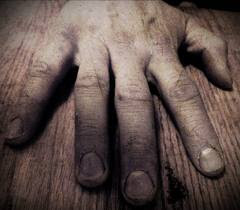












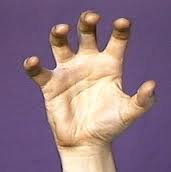

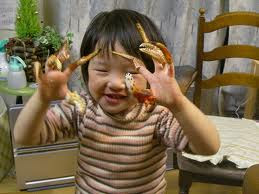





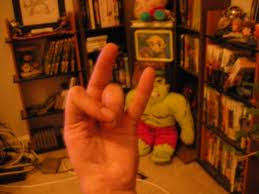


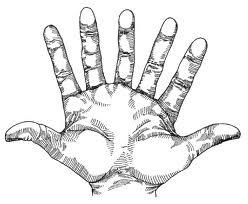






















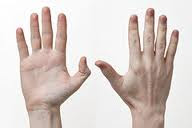











No comments:
Post a Comment